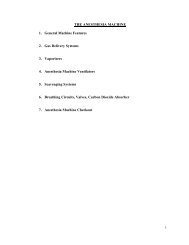BUMC Basics.pdf - Anesthesia Home
BUMC Basics.pdf - Anesthesia Home
BUMC Basics.pdf - Anesthesia Home
You also want an ePaper? Increase the reach of your titles
YUMPU automatically turns print PDFs into web optimized ePapers that Google loves.
86<br />
Invasive Mechanical Ventilation (MV) Modes<br />
Pressure Support Ventilation (PSV): *NOTE: This mode is<br />
only for patients with an intact respiratory drive*<br />
• Patient initiates a breath, which is supported by vent at a<br />
preset pressure<br />
• Flow cycled NOT volume cycled like in SIMV/AC<br />
• “Pressure Support” = inspiratory pressure selected to<br />
achieve adequate TV and ventilatory support<br />
• Can be combined w/ SIMV to partially assist<br />
spontaneous breaths<br />
• Could be considered to make patient more “comfortable”<br />
on vent; also used for SBT at the appropriate level.<br />
Synchronized Intermittent Mechanical Ventilation (SIMV):<br />
• Patient receives vent support at a given tidal volume and<br />
respiratory rate. If patient initiates additional breaths, the<br />
vent provides no support to these breaths unless pressure<br />
support is added.<br />
• This mode has been proposed to prevent respiratory<br />
alkalosis; however, it requires more respiratory muscle<br />
work than AC.<br />
• Used primarily in SICU<br />
Assist-Controlled Mechanical Ventilation (AC): Can set volume<br />
targeted or pressure targeted.<br />
• When using volume targeted: Patient receives vent<br />
support at a given tidal volume and respiratory rate. If<br />
patient initiates additional breaths, the vent delivers the<br />
pre-set tidal volume with each additional breath.<br />
• If the patient is tachypnic, then hyperventilation can<br />
occur<br />
Other modes to minimize lung injury:<br />
• High Frequency Jet Ventilation/Oscillation: Alveoli are<br />
kept fully open as if the patient is kept at full inspiration<br />
while gases are exchanged by oscillating the air at high<br />
frequency<br />
Indications for intubation<br />
• Refractory hypoxemia<br />
• Hypercapnea with respiratory acidosis (note that<br />
patients w/ COPD often live w/ pCO2 b/t 50-70)




